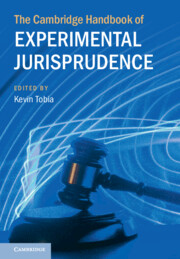Book contents
- The Cambridge Handbook of Experimental Jurisprudence
- The Cambridge Handbook of Experimental Jurisprudence
- Copyright page
- Contents
- Contributors
- Acknowledgments
- Dedication
- Part I Foundations and Theory
- Part II Introductions
- Part III Applications
- 23 Moral Judgments about Retributive Vigilantism
- 24 How Much Harm Does It Take? An Experimental Study on Legal Expertise, the Severity Effect, and Intentionality Ascriptions
- 25 Human Perceptions of AI-Caused Harm
- 26 Reasonableness from an Experimental Jurisprudence Perspective
- 27 The Meaning of “Reasonable”
- 28 Commonsense Consent and Action Representation
- 29 Who Caused It? Different Effects of Statistical and Prescriptive Abnormality on Causal Selection in Chains
- 30 Ownership for and against Control
- 31 Examining the Foundations of the Law of Judicial Bias
- 32 The Promise and the Pitfalls of Mock Jury Studies
- 33 Legal Interpretation as Coordination
- 34 Legal Ambiguities
- 35 Cross-Cultural Perceptions of Rights for Future Generations
- 36 The Right to Transgender Identity
- 37 The Legal Conductome
- 38 Trial by Internet
- Index
- References
30 - Ownership for and against Control
from Part III - Applications
Published online by Cambridge University Press: 17 May 2025
- The Cambridge Handbook of Experimental Jurisprudence
- The Cambridge Handbook of Experimental Jurisprudence
- Copyright page
- Contents
- Contributors
- Acknowledgments
- Dedication
- Part I Foundations and Theory
- Part II Introductions
- Part III Applications
- 23 Moral Judgments about Retributive Vigilantism
- 24 How Much Harm Does It Take? An Experimental Study on Legal Expertise, the Severity Effect, and Intentionality Ascriptions
- 25 Human Perceptions of AI-Caused Harm
- 26 Reasonableness from an Experimental Jurisprudence Perspective
- 27 The Meaning of “Reasonable”
- 28 Commonsense Consent and Action Representation
- 29 Who Caused It? Different Effects of Statistical and Prescriptive Abnormality on Causal Selection in Chains
- 30 Ownership for and against Control
- 31 Examining the Foundations of the Law of Judicial Bias
- 32 The Promise and the Pitfalls of Mock Jury Studies
- 33 Legal Interpretation as Coordination
- 34 Legal Ambiguities
- 35 Cross-Cultural Perceptions of Rights for Future Generations
- 36 The Right to Transgender Identity
- 37 The Legal Conductome
- 38 Trial by Internet
- Index
- References
Summary
Owners generally get to decide what happens to their property, and this is reflected in legal discussions of property rights and in how children and adults view ownership. Owners’ control over property fits with the idea that ownership serves to reduce conflicts over resources. This chapter first briefly reviews experimental research that fits with this side of ownership. However, the chapter then reviews ways that ownership can take control away from owners. One line of research work shows that children and adults think that nonowners are sometimes allowed to access and even modify property without the owner’s permission. A second line of research shows that whereas people normally have some choice in acquiring ownership or giving it up, people sometimes are viewed as acquiring and retaining ownership even when they do not want to.
Information
- Type
- Chapter
- Information
- The Cambridge Handbook of Experimental Jurisprudence , pp. 502 - 513Publisher: Cambridge University PressPrint publication year: 2025
